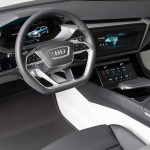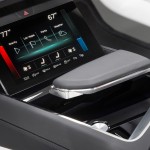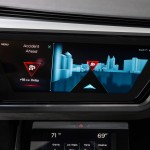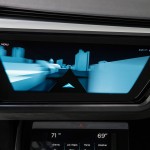Electrification, digitalisation and piloted driving have all been combined in Audi’s latest electric car, the e-tron quattro concept. The Audi e-tron quattro concept is an electrically powered sport SUV, driven by three electric motors that provide all-wheel quattro drive with a total output of up to 370 kW. Torque vectoring is in-built to enhance cornering capability and stability. The 95 kWh battery, the same size as of that seen in VW’s BUDD-e concept, is located between the axles rather than being a flat floor and should be powerful enough to give more than 310 miles electric range. The Audi e-tron quattro concept car is a preview of a future production model that will arrive on the market in 2018.
The car is being used as a showcase for Audi’s innovative interior design ideas that include piloted autonomous driving ability, OLED curved displays, Audi’s virtual cockpit technology and a plethora of new multimedia functions that add to the theme of, “connected car”. You can read more detail on this by referring to the press release extract below.
User-friendly operation is an Audi strength, and now the brand with the four rings is expanding its operating and display concept (HMI, human-machine interface) with new solutions. The concept is being presented in an interior mock-up of the Audi e-tron quattro concept car. The curved OLED (OLED: Organic Light Emitting Diodes) of the new Audi virtual cockpit lies in the driver’s immediate visual field.
The AMOLED (AMOLED: Active Matrix Organic Light Emitting Diodes) technology that is used offers new creative freedoms in designing display shapes. The two displays of the Audi MMI on the centre console offer an outlook on the digital future. Key functions can also be controlled conveniently by voice. Both displays exploit the advantages of a new type of touch recognition – what is known as Audi MMI touch response. Here, the selected functions are activated by gentle yet defined pressure on the display. This makes it possible to operate the system safely and with few distractions while driving.
Behind the new operating and display concept is the latest extension stage of the Audi Modular Infotainment Platform, MIB2+. Its further boosted computing power makes it possible to drive several high-resolution displays.
MIB2+ has been prepared for the latest mobile communications standard: LTE Advanced. It can download data into the car at a maximum speed of 300 Mbit/s. LTE Advanced also enables mobile telephony using the VoLTE (VoLTE = Voice over LTE) method, which shortens the time needed to make a phone connection and increases voice quality. Voice control has also become more powerful – it utilises both the on-board address book and a server in the cloud.
The control and display concepts from Audi are already visionary today. The Audi virtual cockpit – a fully digital instrument cluster with a 12.3-inch TFT display – provides all information in intricately calculated and brilliant 3D graphics, in which drivers can choose between different views. The latest Audi models have MMI terminals on board that follow a new operating logic. This resembles the concept that is familiar from modern smartphones – flat hierarchies instead of complex menu trees. Voice control is available as an alternative.
Audi connect
The term Audi connect covers all applications and developments that network an Audi with its owner, the Internet, infrastructure and other vehicles. Audi continues to extend its lead in this technology field. An LTE/UMTS module of Audi connect connects to the Internet with download speeds of up to 100 MBit/s.
The integrated Wi-Fi hotspot lets passengers freely surf the web, stream and text/e-mail with up to eight mobile devices. Customised services from the Audi connect portfolio are delivered to the car for the driver. They include traffic information online, Google Earth and Google Street View, parking information, fuel prices and flight, train and gate information. The Audi connect lineup is rounded out by City Events, individually configurable news, travel and weather information and other services.
Audi will also be offering additional new services in Europe, and soon in the USA.
They include emergency call that alerts the Audi Emergency Call Centre after an accident, online roadside assistance that calls the Audi Service Centre and Audi service request with which customers can schedule a service appointment.
The free Audi MMI connect app brings more services into the car such as Online Media Streaming, which offers access to the services of the subscription music portals Napster and Rhapsody and the Aupeo! radio service. For owners of the new A4 and Q7 models, the Audi MMI connect app also offers remote vehicle services. From a smartphone, they can lock or unlock the doors or view the latest car status report. They can also have the parking location and parking time displayed. Other functions have been added for the Audi e‑tron models – remote control of battery charging and climate control and access to driving data. The app’s remote functions can also be activated by a smartwatch, and effective at the beginning of 2016 by a fourth-generation Apple TV.
In just a few months, the Audi connect SIM will be available for the new A4 and Q7 models in European markets. It is a permanently installed embedded SIM (e-SIM) that automatically brings Audi connect services into the car across Europe and does not require that the driver perform an activation procedure.
It permits EU-wide roaming, because the SIM card can be automatically set to specific country providers as necessary. This eliminates country-specific roaming fees and annoying roaming confirmations.
Regardless of which connect services are integrated, Audi owners can choose additional data packages for the Audi connect SIM at economical rates to operate the Wi-Fi hotspot. Here too, the data transfer automatically continues at the fixed price when crossing a border, i.e. when switching providers.
In 2016, Audi is expanding its connect lineup to include the first Car-to-X technologies. The services traffic sign information and hazard information make the new Audi models part of a swarm. They report detected speed limits and hazardous locations, e.g. at points where a vehicle has broken down or the road service is slippery, to a server in the cloud via the mobile phone network. The server collects the data, processes it, and provides it to other Audi drivers who have suitable equipment. The updated information also flows into regular map updates for the MMI navigation plus system, making it available to the entire Audi fleet.
The traffic light information service connects the new models in the USA via the mobile phone network to the central traffic computer that controls traffic lights in the city. Based on the information from this system, the Audi virtual cockpit recommends a speed to the driver for reaching the next traffic light while it is green.
Source; Audi




